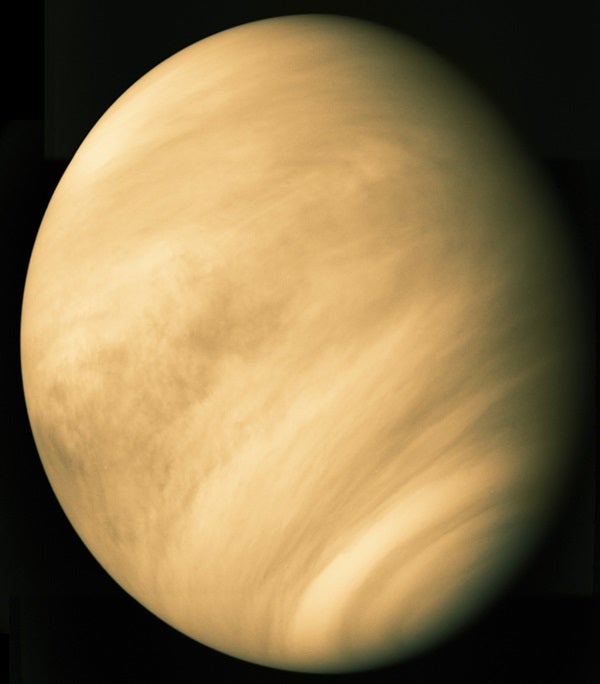Transcript
Venus is the brightest object in our sky after the Sun and Moon, and it appears more than 10 times brighter than the brightest star, Sirius. Because Venus orbits closer to the Sun than Earth does, it never strays far from our star in the sky. It appears either in the western sky after sunset or in the east before dawn. This interior orbit also means that Venus shows phases when viewed through a telescope, just like the Moon. When Galileo first saw the phases of Venus through his early telescope, it provided strong support for the idea that the Sun was at the solar system’s center and not Earth.
Venus measures 7,521 miles across (12,104 kilometers), some 95 percent of Earth’s diameter. And it contains slightly more than 80 percent of Earth’s mass. No other planet in the solar system comes as close to matching Earth. In fact, until the middle of the 20th century, many scientists suspected that Venus was a near twin to Earth. They were wrong — very wrong.
Thick clouds cover Venus, completely shrouding its surface from view. In the early 1960s, astronomers shot radar signals at the planet and learned that it rotates once every 244 Earth days — longer than its 225-day orbit. This makes Venus the only planet in our solar system that takes longer to rotate on its axis than it does to revolve around the Sun.
Planetary scientists soon learned this was not Venus’ only odd characteristic. It has an atmosphere nearly 100 times as dense as Earth’s. The pressure you would feel standing on its surface would be equivalent to being about 3,000 feet, or nearly 1 kilometer, deep in Earth’s ocean. The atmosphere consists almost entirely of carbon dioxide, which acts like a giant blanket and promotes a runaway greenhouse effect that raises the surface temperature to a brutal 900° Fahrenheit (480° Celsius). That’s hot enough to melt lead. Lightning erupts from the clouds, which are made not of water vapor, but of sulfuric acid.
Those clouds kept the surface effectively hidden from view until the mid-1970s, when the Soviet Union landed the first of several probes on the surface. Although they did not last long in the blistering, crushing conditions, these Venera spacecraft returned the first images from Venus’ surface. They revealed blocky, plate-shaped rocks that appear to be volcanic in origin.
In the late 1970s and early ’80s, NASA’s Pioneer Venus Orbiter and two more Soviet Venera spacecraft reached the planet. By using radar to penetrate the clouds, they revealed a world of continentlike highlands separated by seafloorlike lowlands. Folded mountain belts surrounded highland plateaus, resembling the mountain ranges seen at the boundaries of tectonic plates on Earth. Large circular features, named “coronae,” appeared to be collapsed domes. The surface featured lots of volcanoes but relatively few impact craters.
High-resolution global views of the surface had to await NASA’s Magellan radar mapper, which started to orbit Venus in 1990. The new radar images and altimetry data revealed details as small as 330 feet (100 meters) across — at least 10 times better than the previous probes.
Using Magellan, scientists saw incredible details, such as in this perspective view of the 5-mile-high (8 kilometers) volcano Maat Mons. Lava flows extend hundreds of miles from the volcano’s peak, aided by Venus’ high surface temperature, which keeps the lava liquid. In this image, the vertical scale has been exaggerated 10 times.
This striking corona apparently formed when a plume of magma originating in Venus’ mantle rose to the surface. Eventually, the plume waned and the structure collapsed over the old magma chamber.
The biggest surprise of the Magellan mission had to be the low number of impact craters, which implies that the planet’s surface is young. In geological terms, this means it is less than 1 billion years old, similar to the average age of Earth’s crust. But the craters on Venus spread out randomly and are not bunched together, so apparently no older crust remains.
Many planetary scientists now think intense volcanism resurfaced Venus about 500 million years ago, but then died relatively quickly. If true, it makes Venus unique in the solar system. Mercury, the Moon, and Mars all had volcanism early in their histories, but the activity died some 3 billion years ago. Almost all of Earth’s surface is young, and volcanic activity continues to resurface it. Only on Venus did activity ramp up fairly recently and then die down, leaving a surface almost entirely the same age across the planet.










